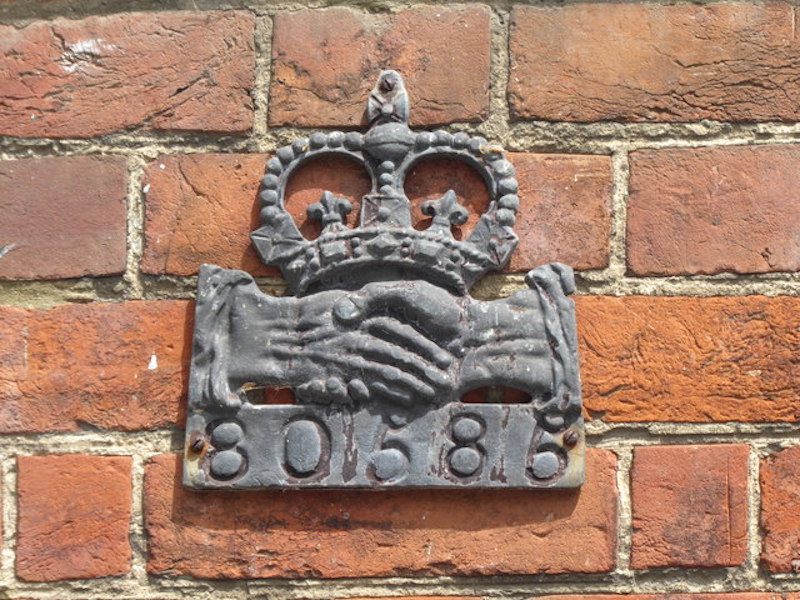A Short History of Fire Marks, The World’s Hottest Insurance-Related Antiques
From decorative advertising to collectible artifacts.

Decorative crests bearing eagles, clasped hands, and shining suns were once signs of membership in a special club. They showed that the building to which they were affixed was insured against fire—and that if the building caught on fire, a private fire brigade would come to attempt to put it out. Now, long after their heyday, these plaques, known as “fire marks,” have become collector’s items—every bit as fascinating and artful today as they were when they were installed.
After the Great Fire of London in September 1666, which damaged or destroyed huge swaths of the historic city, the need for a more organized response to fires became tragically apparent. This led to the creation of the world’s first property insurance policies, issued by what is considered the world’s first insurance company, called the “Fire Office.” Despite its official-sounding name, the Fire Office was not a municipal department, but a private company. At the beginning, it provided money for the restoration or reconstruction of buildings damaged by fire.

Not long after the Fire Office was established, a number of other insurance outfits began to appear. According to the Museum of London, one of every 10 houses in London was insured by 1690. As time passed, many insurance companies wised up to the fact that it was cheaper to prevent and fight fires than simply to pay the cost of reconstruction, and that’s where fire marks come in. Insurance companies such as the Fire Office established their own in-house fire brigades, tasked with protecting the buildings covered under policy—and, in many cases, only those buildings. If another company’s brigade put out a fire in a building insured by a different company, they might be reimbursed for their trouble, but if your building did not carry a crest, it might be left to burn. To designate which buildings were covered by which company’s brigade, fire marks were installed on the exteriors of the buildings.
The Fire Office first used a fitting phoenix symbol on its mark, and other companies employed a wide variety of symbols, from a blazing sun to a building capped by a heraldic crown to a rearing horse, often with the policy number underneath the decoration. Fire marks were often metal plates affixed to exterior, but were sometimes more substantial or worked into the facade itself.
The practice soon spread beyond London. By the end of the 18th century they had made their way across the Atlantic—though in the United States their function wasn’t always quite so pitiless as it was in their initial English form.

By the time that the idea of fire insurance made its way to the Untied States, volunteer fire brigades were already a well-established tradition to protect the common good. Fire marks, which first took hold in Philadelphia, where some can still be found today, functioned simply as insurance advertisements, and as a sort of turf mark. According to a story in Philadelphia Magazine, at least one insurance company in the 1800s offered rewards to fire brigades that got to a fire first, creating rivalries of a sort. It is also said that some of the fire companies were closely related to the city’s street gangs, and the brigades’ work could be used to set up ambushes and fights. Regardless of how they worked in practice, a number of attractive fire marks were installed in the City of Brotherly Love.
The most iconic of Philadelphia’s fire marks was that of the Ben Franklin–founded Philadelphia Contributionship, which bore the image of four hands grabbing each other by the wrists. It was often molded out of metal and affixed to a wooden shield. There was also the mark of the Mutual Insurance Company, a leafy tree that was a direct slam on the Contributionship (which wouldn’t insure properties that had trees in front of them). Just as in London before, as the number of insurance companies grew nationwide, the variety of fire marks grew with them.

By the mid-19th century, London had established a public firefighting operation, and the use of fire marks began to decline. The same trend occurred across the pond, as the prevalence of insurance spread and more effective ways of advertising arose. But fire marks maintained some popularity even as their utility waned.
Today, fire marks survive as historic points of interest or collector’s items. Like philatelists and numismatists (collectors of stamps and coins, respectively), people who study and collect fire marks have a name: signevierists. Probably the most organized group of signevierists is the Fire Mark Circle of America, which oversees a number of auctions and connects enthusiasts. Their auction listings even act as a sort of database of the wide variety of preserved marks being traded around.
In this second life, fire marks have become popular decorative flourishes, and there are even modern recreations floating around. Some home insurance companies still grant buildings new decorative fire marks for a fee. But we are well past the days when these curious little symbols were a sign of security.

















Follow us on Twitter to get the latest on the world's hidden wonders.
Like us on Facebook to get the latest on the world's hidden wonders.
Follow us on Twitter Like us on Facebook